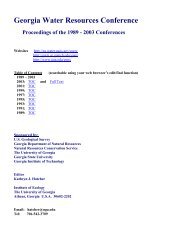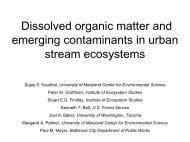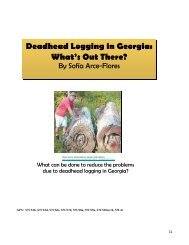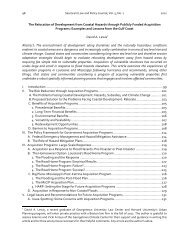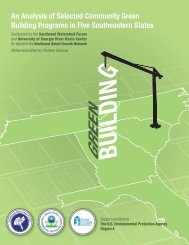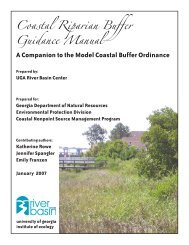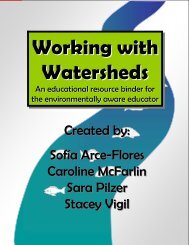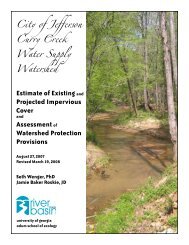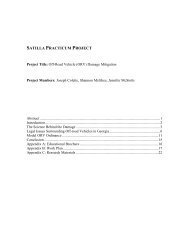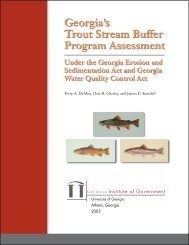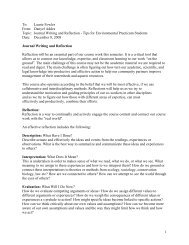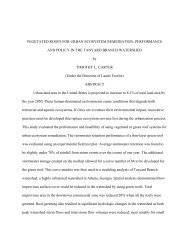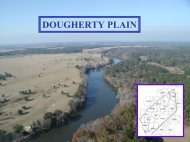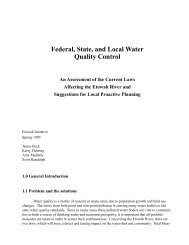1 Bibliographic Review of Sources Relevant to Development of Draft ...
1 Bibliographic Review of Sources Relevant to Development of Draft ...
1 Bibliographic Review of Sources Relevant to Development of Draft ...
Create successful ePaper yourself
Turn your PDF publications into a flip-book with our unique Google optimized e-Paper software.
Savannah River Annotated Bibliography: January 2003<br />
trajec<strong>to</strong>ries in downstream reaches. Flood peaks are typically reduced by river regulation, which<br />
reduces the frequency and extent <strong>of</strong> floodplain inundation. To counter the influence <strong>of</strong> river<br />
regulation, res<strong>to</strong>ration efforts should focus on reestablishing dynamic connectivity between the<br />
channel and floodplain water bodies.<br />
Floodplain nutrient cycling<br />
Clawson, R., B. Lockaby and B. Rummer (2000). "Changes in production and nutrient<br />
cycling across a wetness gradient within a floodplain forest." Ecosystems 4: 126-138.<br />
This article compares multiple indexes <strong>of</strong> productivity, nutrient cycling, and hydroperiod.<br />
Somewhat poorly drained soil had the greatest belowground biomass and the most efficient<br />
retranslocation <strong>of</strong> nitrogen. Poorly drained soil had the greatest woody biomass current annual<br />
increment and overall had the greatest net primary productivity. Hydroperiod affected the<br />
allocation <strong>of</strong> nutrient and biomass resources for trees growing on the floodplain.<br />
Kemp, W. M., M. T. Brooks and R. R. Hood (2001). "Nutrient enrichment, habitat<br />
variability and trophic transfer efficiency in simple models <strong>of</strong> pelagic<br />
ecosystems." Marine Ecology-Progress Series 223: 73-87.<br />
We developed 4 simple numerical models <strong>of</strong> plank<strong>to</strong>n dynamics <strong>to</strong> explore how nutrient<br />
enrichment and habitat variability might influence the efficiency by, which phy<strong>to</strong>plank<strong>to</strong>n (P)<br />
production is transferred <strong>to</strong> growth <strong>of</strong> zooplank<strong>to</strong>n (Z) consumers in coastal ecosystems.<br />
Numerical and analytical studies also showed that, regardless <strong>of</strong> resource variability, these model<br />
formulations produce a trend <strong>of</strong> initial enhancement <strong>of</strong> trophic efficiency with increasing nutrient<br />
levels, followed by a marked reduction inefficiency beginning at moderately eutrophic conditions.<br />
This precipi<strong>to</strong>us drop in trophic efficiency is attributable <strong>to</strong> a saturation <strong>of</strong> the ability <strong>of</strong><br />
zooplank<strong>to</strong>n <strong>to</strong> utilize the increased primary production associated with nutrient enrichment.<br />
Under these conditions, an increasing fraction <strong>of</strong> the primary production is shunted <strong>to</strong> microbial<br />
food chains and associated respira<strong>to</strong>ry losses. The steepness <strong>of</strong> this reduction in trophic efficiency<br />
with nutrient enrichment is related <strong>to</strong> the strength <strong>of</strong> predation (or disease) control at upper trophic<br />
levels. We speculate that these model results may help <strong>to</strong> explain how observed reductions in<br />
relative fish yield (per unit primary production) in many shallow nutrient-enriched estuaries and<br />
lakes are related <strong>to</strong> interacting effects <strong>of</strong> cultural eutrophication and intense fisheries exploitation.<br />
Furthermore, we surmise that these relationships are robust characteristics <strong>of</strong> most existing aquatic<br />
ecosystem models.<br />
Anderson, R., J. Grubaugh and R. Sparks (1986). Macrophyte beds and floodplain<br />
forests; A source or sink for organic matter in a large river. Freshwater Wetlands<br />
and Wildlife Symposium, Charles<strong>to</strong>n, SC.<br />
Baker, T., III, W. Conner, B. Lockaby, J. Stanturf and M. Burke (2001). "Fine root<br />
productivity and dynamics on a forested floodplain in South Carolina." Soil<br />
Science Society <strong>of</strong> America Journal 65(2): 545-556.<br />
Baker, T., III, B. Lockaby, W. Conner, C. Meir, J. Stanturf and M. Burke (2001). "Leaf<br />
litter decomposition and nutrient dynamics in four southern forested floodplain<br />
communities." Soil Science Society <strong>of</strong> America Journal 65(4): 1334-1347.<br />
Brinson, M. M. (1977). "Decomposition and Nutrient Exchange <strong>of</strong> Litter in an Alluvial<br />
Swamp Forest." Ecology 58(3): 601-609.<br />
22



